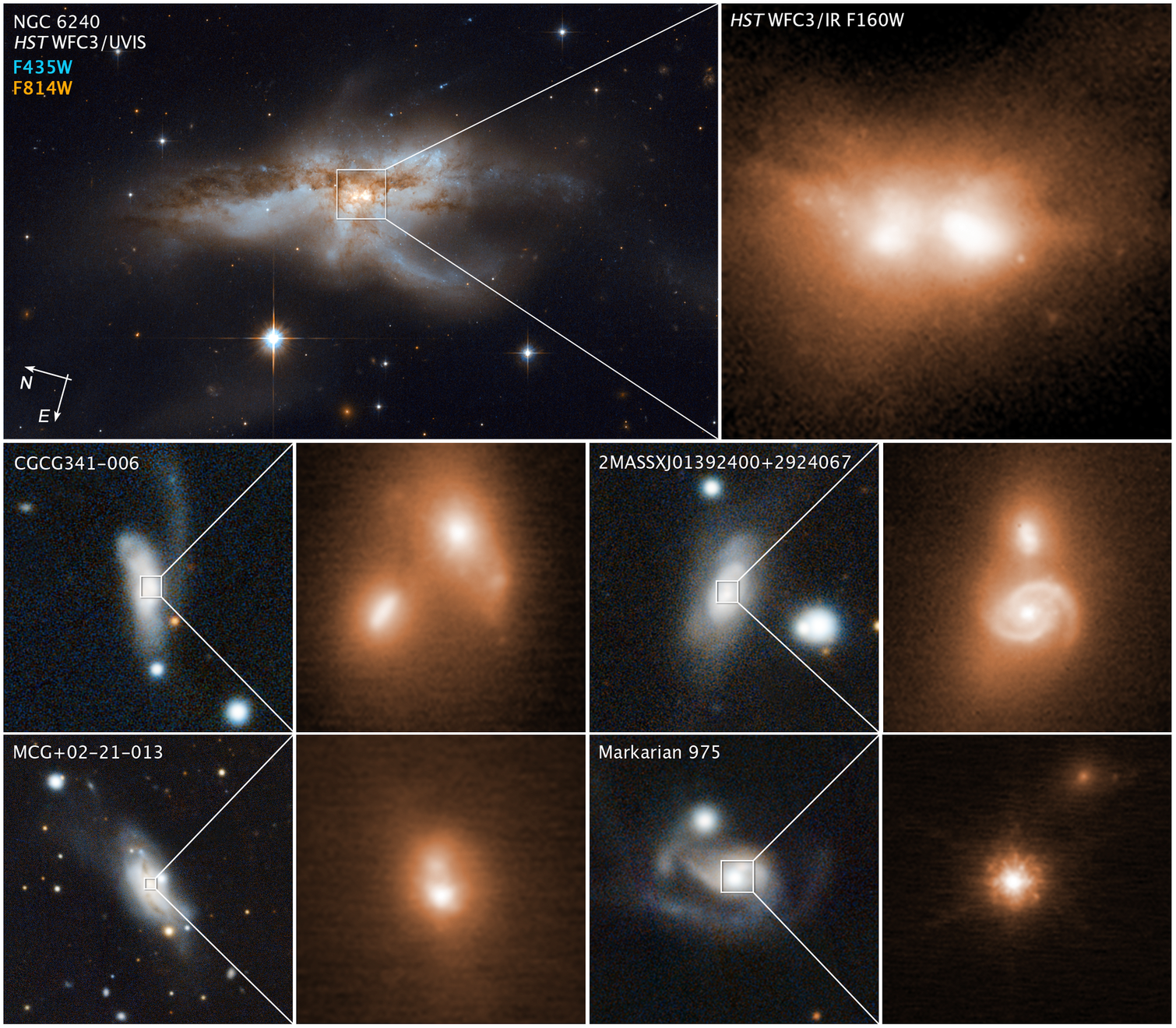1 min read
Galaxy Mergers

Hubble and Keck Observatories Uncover Black Holes Coalescing
These images reveal the final stage of a union between pairs of galactic nuclei in the messy cores of colliding galaxies.
The image at top left, taken by Hubble's Wide Field Camera 3, shows the merging galaxy NGC 6240. A close-up of the two brilliant cores of this galactic union is shown at top right. This view, taken in infrared light, pierces the dense cloud of dust and gas encasing the two colliding galaxies and uncovers the active cores. The hefty black holes in these cores are growing quickly as they feast on gas kicked up by the galaxy merger. The black holes' speedy growth occurs during the last 10 million to 20 million years of the merger.
Images of four other colliding galaxies, along with close-up views of their coalescing nuclei in the bright cores, are shown beneath the snapshots of NGC 6240. The images of the bright cores were taken in near-infrared light by the W. M. Keck Observatory in Hawaii, using adaptive optics to sharpen the view.
The reference images (left) of the merging galaxies were taken by the Panoramic Survey Telescope and Rapid Response System (Pan-STARRS).
The two nuclei in the Hubble and Keck Observatory photos are only about 3,000 light-years apart — a near-embrace in cosmic terms. If there are pairs of black holes, they will likely merge within the next 10 million years to form a more massive black hole.
These observations are part of the largest-ever survey of the cores of nearby galaxies using high-resolution images in near-infrared light taken by the Hubble and Keck observatories.
The survey galaxies' average distance is 330 million light-years from Earth.
About the Data
- Data DescriptionData DescriptionProposal: A description of the observations, their scientific justification, and the links to the data available in the science archive.
Science Team: The astronomers who planned the observations and analyzed the data. "PI" refers to the Principal Investigator.The Hubble image was created using HST data from proposal 10592: A. Evans (University of Virginia, Charlottesville/NRAO/Stony Brook University) - InstrumentInstrumentThe science instrument used to produce the data.ACS/WFC; WFC3/IR
- Exposure DatesExposure DatesThe date(s) that the telescope made its observations and the total exposure time.10 February 2002; 12 February 1998
- FiltersFiltersThe camera filters that were used in the science observations.F435W, F814W; F160W
- Object NameObject NameA name or catalog number that astronomers use to identify an astronomical object.Merging Galaxies: NGC 6240, CGCG 341-006, 2MASSXJ 01392400+2924067, MCG+02-21-013, Markarian 975
- Object DescriptionObject DescriptionThe type of astronomical object.Close-up views of the cores of colliding galaxies
- Release DateNovember 7, 2018
- Science ReleaseAstronomers Unveil Growing Black Holes in Colliding Galaxies
- Credit

These images are a composite of separate exposures acquired by the ACS/WFC and WFC3/IR instruments on the Hubble Space Telescope. Several filters were used to sample narrow wavelength ranges. The color results from assigning different hues (colors) to each monochromatic (grayscale) image associated with an individual filter. In this case, the assigned colors are: Cyan: F435W Orange: F814W Monochrome Orange: F160W

Share
Details
Claire Andreoli
NASA’s Goddard Space Flight Center
Greenbelt, Maryland
claire.andreoli@nasa.gov





























